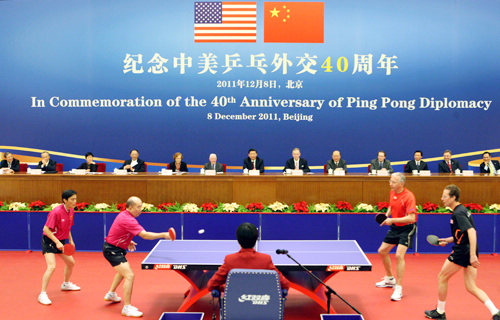|
 |
|
Chinese Vice President Xi Jinping (center, back) and former U.S. President Jimmy Carter (6th left, back) watch a friendship match during an activity marking the 40th anniversary of Ping Pong Diplomacy, which led to the establishment of diplomatic relations between China and the United States, in Beijing, on December 8 (YAO DAWEI) |
Military Exchanges
Deputy Chief of General Staff of the Chinese People's Liberation Army, Ma Xiaotian, and U.S. Under Secretary of Defense for Policy, Michele Flournoy, led their respective delegations at the 12th round of China-U.S. defense consultation talks in Beijing on December 7.
The two sides discussed bilateral military relations, U.S. arms sales to Taiwan, tension on the Korean Peninsula and the South China Sea, instability in the Middle East and North Africa, and the security situation in Pakistan and Afghanistan, according to the Xinhua News Agency.
The consultations marked the first engagement between defense authorities of both countries since the United States announced in September that its latest, $5.85-billion, arms deal with Taiwan.
China vehemently opposed the sale, saying it created severe obstacles for normal military-to-military exchanges. China-U.S. defense consultations began in 1997.
Satellite Development
China will develop the third-generation Fengyun series of weather satellites to monitor meteorological changes more accurately and to help tackle climate change.
"The new satellites will be able to monitor the meteorological system and different layers of the atmosphere in a long-term and more consistent way," said Yu Rucong, Deputy Director of the China Meteorological Administration at a seminar on December 5.
The satellites will also collect data and images of atmospheric temperature, humidity and wind with higher definition and accuracy than previous satellites, which will support more reliable weather forecasting.
China has launched 11 Fengyun weather satellites over the past 40 years. Six are currently in operation.
Scientific Papers
The Chinese mainland published 121,500 academic papers on science and technology in major international journals in 2010, accounting for 8.6 percent of the world's total.
The statistics are based on a survey of papers indexed by renowned international databases such as the Science Citation Index and the Engineering Index, according to a report issued on December 2 by the Institute of Scientific and Technical Information of China under the Ministry of Science and Technology.
The number of Chinese theses published in the world's 173 highestrated publications—including Science and Nature—reached 5,203 last year. The figures indicate that China is second only to the United States in terms of the number of scientific papers published.
Job Training
China has issued various occupational qualification certificates to nearly 500,000 disabled citizens in the past five years, according to the China Disabled Persons' Federation.
A total of 3.76 million disabled people nationwide received some form of vocational or technical training during the 2005-10 period, said a statement released on December 6.
The federation said that it will train another 1.8 million disabled people in the next five years and will launch a variety of programs in order to make millions more employable.
Nearly 83 million citizens in China have some form of disability. | 